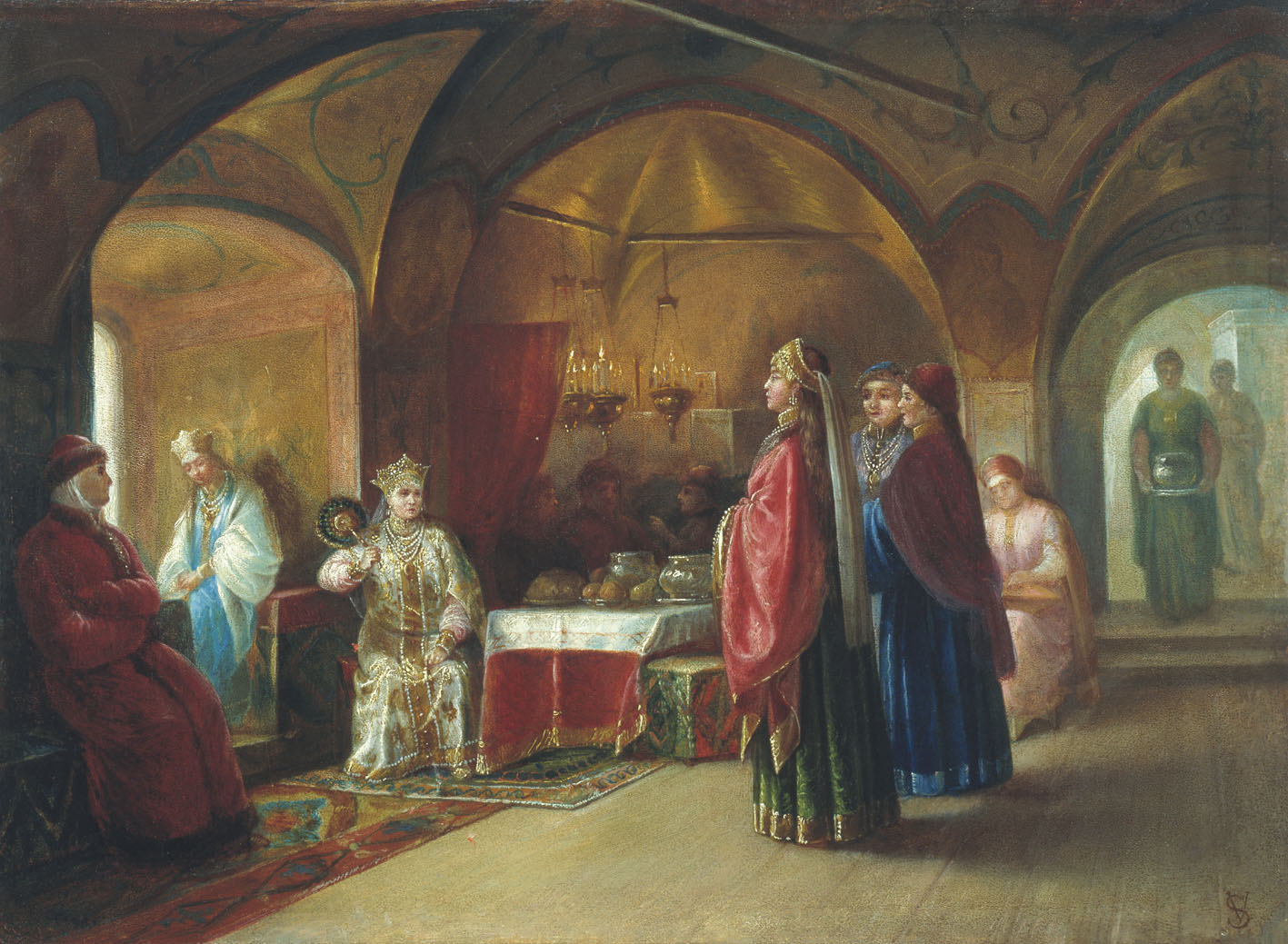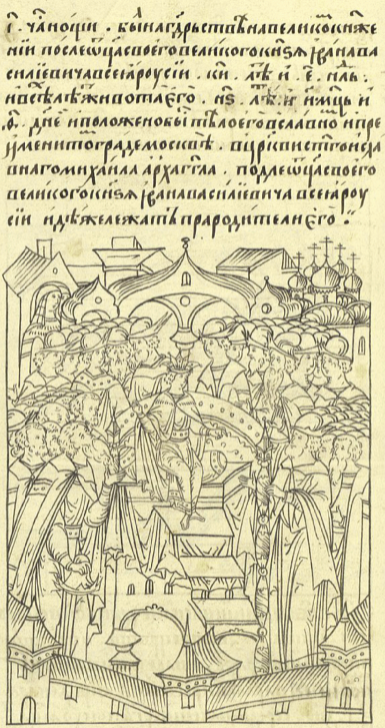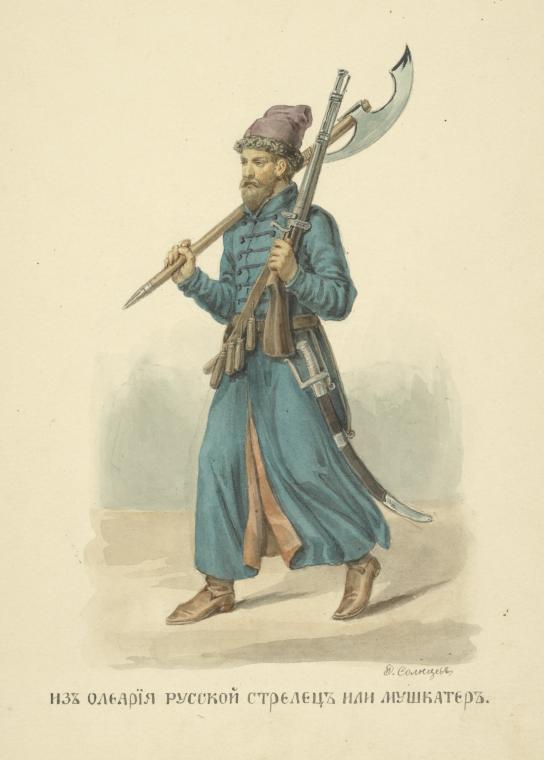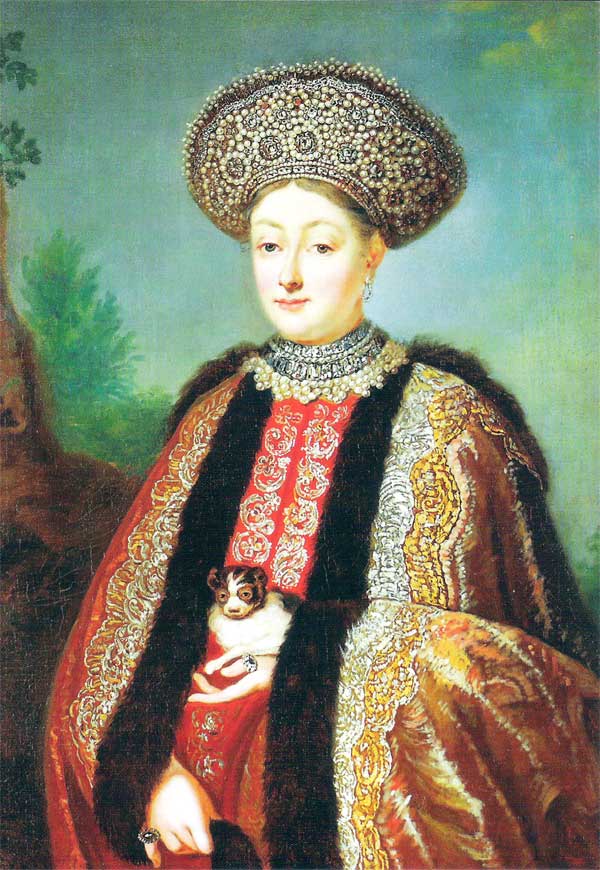|
Sofia Alekseyevna
Sophia Alekseyevna ( rus, Со́фья Алексе́евна, p=ˈsofʲjə ɐlʲɪˈksʲejɪvnə; ) was a Russian princess who ruled as regent of Russia from 1682 to 1689. She allied herself with a singularly capable courtier and politician, Prince Vasily Golitsyn, to install herself during the minority of her brother Ivan V and half-brother Peter I. She carried out her regency with a firm hand. The activity of this " bogatyr- tsarevna", as Sergey Solovyov called her, was all the more extraordinary, as upper-class Muscovite women were confined to the upper-floor '' terem'', veiled and guarded in public, and invariably kept aloof from any open involvement in politics. Early life Sophia was the third surviving daughter of Tsar Alexis by his first wife, Maria Miloslavskaya. She was the only one of her sisters educated by Simeon Polotsky, who also taught Tsar Alexis' heirs Tsarevich Alexei and Tsarevich Feodor. After the death of her brother Tsar Feodor III on 27 April 16 ... [...More Info...] [...Related Items...] OR: [Wikipedia] [Google] [Baidu] |
Tsarevna
Tsarevna (, ) was a title given to the daughters of tsars in Russia before the 18th century. The male equivalent was ''tsarevich''. All of them died unmarried with the exception of the daughters of Ivan V. Notably, his daughter Catherine married Karl Leopold of Mecklenburg-Schwerin. Both ''tsarevna'' and ''tsarevich'' were replaced with '' grand duchess'' and ''grand duke'' (with ''tsesarevich'' given to the heir apparent An heir apparent is a person who is first in the order of succession and cannot be displaced from inheriting by the birth of another person. A person who is first in the current order of succession but could be displaced by the birth of a more e ...). References External links * Russian royalty Titles {{Russia-hist-stub ... [...More Info...] [...Related Items...] OR: [Wikipedia] [Google] [Baidu] |
Terem (Russia)
The "terem" (Russian language, Russian: Терем) refers to the separate living quarters occupied by elite women of the Principality of Moscow and Tsardom of Russia. Also, the upper story of a home or castle, often with a pitched roof. More broadly, the term is used by historians to discuss the elite social practice of female seclusion that reached its height in the seventeenth century. Royal or noble women were not only confined to separate quarters, but were also prevented from socialization with men outside their immediate family, and were shielded from the public eye in closed carriages or heavily concealing clothing. The word is not to be confused with the Terem Palace in Moscow, an extended part of the Grand Kremlin Palace, which was not occupied exclusively by women. Etymology Although the origins of the practice are still a matter of debate among historians, it is generally believed that the word "terem" comes from the Proto-Slavic root ''*term'' (dwelling). Its usag ... [...More Info...] [...Related Items...] OR: [Wikipedia] [Google] [Baidu] |
Raskol
The Schism of the Russian Church, also known as (, , meaning 'split' or 'schism'), was the splitting of the Russian Orthodox Church into an official church and the Old Believers movement in the 1600s. It was triggered by the reforms of Patriarch Nikon in 1653, which aimed to establish uniformity between Greek and Russian church practices. In the 1630s and 1640s, Nikon had been a part of a group known as the Zealots of Piety, a circle of church reformers whose acts included amending service books in accordance with the "correct" Russian tradition. When Nikon became Patriarch of Moscow in 1652, he continued the practice of amending books under the guidance of Greek Orthodox advisors, changing practices in the Russian Church to align with the Greek rite. This act, along with the acceptance of the Nikonian reforms by Tsar Alexei Mikhailovich and the state, led to the rupture between Old Believers and the newly reformed church and state. The schism contributed to popular uprisin ... [...More Info...] [...Related Items...] OR: [Wikipedia] [Google] [Baidu] |
Old Believers
Old Believers or Old Ritualists ( Russian: староверы, ''starovery'' or старообрядцы, ''staroobryadtsy'') is the common term for several religious groups, which maintain the old liturgical and ritual practices of the Russian Orthodox Church, as they were before the reforms of Patriarch Nikon of Moscow between 1652 and 1657. The old rite and its followers were anathematized in 1667, and Old Belief gradually emerged from the resulting schism. The antecedents of the movement regarded the reform as heralding the End of Days, and the Russian church and state as servants of the Antichrist. Fleeing persecution by the government, they settled in remote areas or escaped to the neighboring countries. Their communities were marked by strict morals and religious devotion, including various taboos meant to separate them from the outer world. They rejected the Westernization measures of Peter the Great, preserving traditional Russian culture, like long beards for men. ... [...More Info...] [...Related Items...] OR: [Wikipedia] [Google] [Baidu] |
Sophia Alekseyevna, By Ilya Repin
Sophia most commonly refers to: * Sophia (wisdom), a central idea in Hellenistic philosophy and religion * Sophia (Gnosticism), a feminine figure in Gnosticism * Sophia (given name), including a list of people and fictional characters named Sophia or Sofia Sophia or SOPHIA may also refer to: Arts and entertainment Music * Sophia (Japanese band) * Sophia (singer) or Sophia Abrahão, pop singer from Brazil * ''Sophia'' (The Crüxshadows EP) * ''Sophia'' (Sophia Abrahão EP) * "Sophia" (Nerina Pallot song) * "Sophia" (Laura Marling song) * "Sophia", a song from '' Think Before You Speak'' by Good Shoes * "Sophia", a song from ''Mother's Spiritual'' by Laura Nyro * "Sophia", a song from '' Dust and Chimes'' by Six Organs of Admittance Other uses in arts and entertainment * ''Sophia'' (TV series), a Russian historical drama * ''Sophia'' (novel) by Charlotte Lennox (1762) People and fictional characters * Sophia (given name), including a list of people and fictional characters ... [...More Info...] [...Related Items...] OR: [Wikipedia] [Google] [Baidu] |
Ivan IV
Ivan IV Vasilyevich (; – ), commonly known as Ivan the Terrible,; ; monastic name: Jonah. was Grand Prince of Moscow and all Russia from 1533 to 1547, and the first Tsar and Grand Prince of all Russia from 1547 until his death in 1584. Ivan's reign was characterised by Russia's transformation from a medieval state to a fledgling empire, but at an immense cost to its people and long-term economy. Ivan IV was the eldest son of Vasili III by his second wife Elena Glinskaya, and a grandson of Ivan III. He succeeded his father after his death, when he was three years old. A group of reformers united around the young Ivan, crowning him as tsar in 1547 at the age of 16. In the early years of his reign, Ivan ruled with the group of reformers known as the Chosen Council and established the ''Zemsky Sobor'', a new assembly convened by the tsar. He also revised the legal code and introduced reforms, including elements of local self-government, as well as establishing the first ... [...More Info...] [...Related Items...] OR: [Wikipedia] [Google] [Baidu] |
Domostroy
''Domostroy'' (, , ) is a 16th-century Russian set of household rules, instructions and advice pertaining to various religious, social, domestic, and family matters of Russian society. Core ''Domostroy'' values tended to reinforce obedience and submission to God, the tsar, and the church. Key obligations were fasting, prayer, icon veneration and the giving of alms. Description Its real author is unknown, but the most widespread version was edited by the archpriest Silvester, an influential advisor to Ivan IV of Russia. The text does include an epistle entitled "64. A Father's Epistle Instructing His Son", which was written by Silvester instructing his son, Anfim, on some of the larger themes found within the ''Domostroy''. An updated edition of the ''Domostroy'' was compiled by Karion Istomin during the late 17th century. To modern researchers, it is a precious account of Russian society and the life of wealthy boyars and merchants. The first part of the ''Domostroy'' is ... [...More Info...] [...Related Items...] OR: [Wikipedia] [Google] [Baidu] |
Patriarch Joachim Of Moscow
Patriarch Joachim (; January 6, 1620 – March 17, 1690) was the eleventh Patriarch of Moscow and All Russia, an opponent of the '' Raskol'' (the Old Believer schism), and a founder of the Slavic Greek Latin Academy. Born Ivan Petrovich Savelov (Иван Петрович Савелов) also in some other sources as Ivan Petrovich Savyolov, Joachim was of noble origin. When his family died in the 1654 epidemic, he became a monk and served in various monasteries, receiving the religious name Joachim upon his tonsure. In 1664, Joachim was elevated to the rank of archimandrite and became hegumen (abbot) of the Chudov Monastery and in 1672 was consecrated as Metropolitan of Novgorod.Pavel Tikhomirov, ''Kafedra Novgorodskikh Sviatitelei'' (Novgorod, 1895), vol. 2. He was elected a Patriarch on July 26, 1674, following the death of Patriarch Pitirim. Although Joachim had participated in the council which deposed Patriarch Nikon, he continued Nikon's policies with ... [...More Info...] [...Related Items...] OR: [Wikipedia] [Google] [Baidu] |
Naryshkin Family
The House of Naryshkin () is a noble Russian boyar family of Crimean Tatar descent, going back to a certain Mordko Kurbat Naryshko, who moved to Moscow in the 15th century.Sergei O. Prokofieff, ''The Spiritual Origins of Eastern Europe and the Future Mysteries of the Holy Grail'', Temple Lodge Publishing (1993), p. 460 It became allied to the ruling house in 1671 when the great beauty Natalya Naryshkina (daughter of Kirill Poluektovich Naryshkin) married Alexis of Russia, later becoming the mother of Peter the Great. The Naryshkin family was persecuted under the regency of Tsarevna Sophia Alekseyevna of Russia, but were then highly favoured by Peter and his descendants and played a major part in Russian life. Streltsy revolt against Naryshkin family During the Streltsy uprising, soldiers of the Streltsy staged a revolt against the Naryshkin family (the relatives of Peter's mother, who had assumed actual power). Their uprising was crushed and their unit were forcibly disband ... [...More Info...] [...Related Items...] OR: [Wikipedia] [Google] [Baidu] |
Streltsy
The streltsy (, ; , ) were the units of Russian firearm infantry from the 16th century to the early 18th century and also a social stratum, from which personnel for streltsy troops were traditionally recruited. They are also collectively known as ''streletskoye voysko'' (). These infantry troops reinforced feudal levy horsemen or ''Landed Army, pomestnoye voysko'' (). The first units were established by Ivan the Terrible as part of the first Russian standing army. The streltsy were under the administration of the ''Streletsky prikaz'' from 1571. Peter the Great curtailed the influence of the streltsy, and following the streltsy uprising of 1698, streltsy units began to be disbanded. However, it was not until the 1720s that this process was completed. Origins and organization The first streltsy units were created by Ivan the Terrible sometime between 1545 and 1550 and armed with Arquebus, arquebuses. During his reign, Russia was fighting wars almost continuously, including ... [...More Info...] [...Related Items...] OR: [Wikipedia] [Google] [Baidu] |
Moscow Uprising Of 1682
The Moscow uprising of 1682, also known as the Streltsy uprising of 1682 (), was an Rebellion, uprising of the Moscow Streltsy regiments that resulted in supreme power devolving on Sophia Alekseyevna, the daughter of the late Tsar Alexis I of Russia, Aleksey Mikhailovich and of his first wife Maria Miloslavskaya. Behind the uprising lurked the rivalry between the Miloslavsky and Naryshkin relatives of the two wives of the late Tsar Aleksey, who died in 1676, for dominant influence on the administration of the Tsardom of Russia. Course of events The death of Tsar Feodor III of Russia on 27 April (7 May Old Style and New Style dates, N.S.) 1682 triggered the uprising. The Naryshkin brothers of Tsarina Natalia Naryshkina availed themselves of the interregnum and persuaded the Patriarch to proclaim her ten-year-old son Peter I of Russia, Peter as the new Tsar of Russia. The Miloslavsky party, which comprised the relatives of the late Tsarina Maria Miloslavskaya, spread rumours that t ... [...More Info...] [...Related Items...] OR: [Wikipedia] [Google] [Baidu] |
Feodor III Of Russia
Feodor or Fyodor III Alekseyevich (; 9 June 1661 – 7 May 1682) was Tsar of all Russia from 1676 until his death in 1682. Despite poor health from childhood, he managed to pass reforms on improving meritocracy within the civil and military state administration as well as founding the Slavic Greek Latin Academy. Life Born in Moscow, Fyodor, as the eldest surviving son of Tsar Alexis and Maria Miloslavskaya, succeeded his father on the throne in 1676 at the age of fifteen. He had a fine intellect and a noble disposition; he had received an excellent education at the hands of Simeon Polotsky, the most learned Slavonic monk of the day. He knew Polish and even possessed the unusual accomplishment of Latin. He had been disabled from birth, however, horribly disfigured and half paralysed by a mysterious disease, supposedly scurvy. He spent most of his time with young nobles, and . On 28 July 1680 he married a noblewoman, Agaphia Simeonovna Grushevskaya (1663–1681), daughter o ... [...More Info...] [...Related Items...] OR: [Wikipedia] [Google] [Baidu] |







